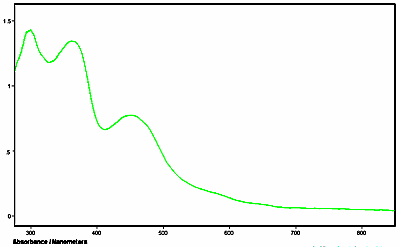CRAIC Technologies is the worlds leading developer of UV-visible-NIR range scientific instruments for microanalysis. These include the QDI series UV-visible-NIR microspectrophotometer instruments designed to help you non-destructively measure the optical properties of microscopic samples. CRAIC's UVM series microscopes cover the UV, visible and NIR range and help you analyze with sub-micron resolutions far beyond the visible range. CRAIC Technologies also has the CTR series Raman microspectrometer for non-destructive analysis of microscopic samples. And don't forget that CRAIC proudly backs our microspectrometer and microscope products with unmatched service and support.
Microspectroscopy of Semiconductor Wafers
UV-visible-NIR microspectroscopic analysis of thin films on semiconductor wafers is one of the most common applications of the technique. In the UV-visible-NIR range, the interference spectra can be used to determine the thickness of films deposited on a silicon wafer. Among the advantages of the technique is the fact that the further into the UV the measurements are made, the thinner the films that can be analyzed. Conversely, the instrument may also determine thick film thicknesses by moving further into the red or longer wavelength regions of the spectrum. In addition, UV-visible-NIR microspectroscopy is non-destructive and the sample preparation is minimal. The purpose of this paper is to detail the utility of the technique and to show some sample results.
Experimental and Results
A printed test semiconductor chip is used as a sample. Bare silicon is used as the reference. No further preparation is required. The sample is now ready to analyze via microspectroscopy.
A QDI 100™ UV-visible-NIR range microspectrophotometer was used for the analysis. The Quantum Detection Instrument series (QDI) of microspectrophotometers is designed to detect the smallest changes in the spectra of microscopic samples. The QDI 100™ microspectrophotometer features a scientific grade array CCD detector, TE cooling, high spectral resolution, long-term stability, low noise, and the ability to acquire transmission, reflectance, and fluorescence spectra of samples as small as 1 x 1 microns.
The sample is placed on the QDI 100™ and the image is acquired. The microscope is set up for Koehler illumination with reflectance illumination. Figure 1 displays an image of the semiconductor chip analyzed. The software automatically optimizes the instrument and the spectra are acquired by simply placing the black square over the area of the layer of paint to be analyzed. A spectrum is acquired and the result is stored on the computer for later analysis.

Figure 1. Image of semiconductor chip. The black square is the microspectrophotometer aperture.
The Figure 2 shows the results of scanning each colored section in the chip. Figure 2 is an overlay spectra of the reflectance spectrum of blue, red and white sections. The spectral range is from 200 to 850 nm using a stabilized xenon lamp and a CCD detector. The spectrum is the average of 50 scans at 100 milliseconds per scan with an aperture of 10 x 10 microns.

Figure 2. Overlay plot of the reflectance spectra of the red white and blue sections.
Figure 3 shows the results of taking spectra of the blue section in five different locations on the chip. This proves the high stability and reproducibility of the instrument. If required, the thickness of the films for each section could then be determined.

Figure 3. Overlay plot of the reflectance spectra of the blue layers taken at five different locations.
It is simple to acquire spectral information and the interference patterns from various locations on a semiconductor chip non-destructively. The quality of the results from the QDI 100™ microspectrophotometer, both in terms of the spectra and the high-resolution images, back this assertion. Using optional software, the thickness of the films deposited at each location could also be determined, in addition to building a database for QC purposes.
Primary author: Dr. Paul Martin
Source: Ultraviolet-Visible-NIR Reflectance Microspectroscopy of Semiconductor Wafers

This information has been sourced, reviewed and adapted from materials provided by CRAIC Technologies.
For more information on this source, please visit CRAIC Technologies.